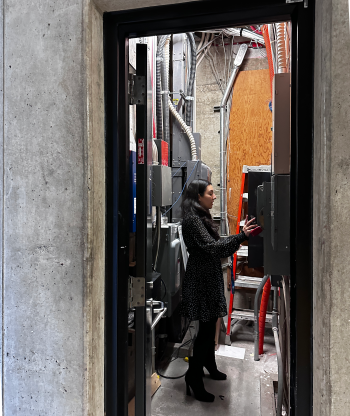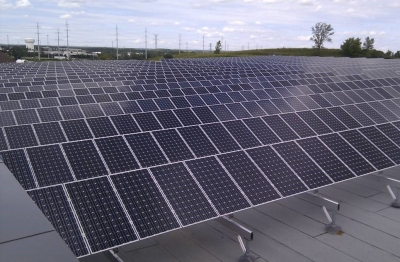U of T Scarborough's electrical system powers all buildings on the growing campus. Meeting the electrical needs of an institution this big—lighting, mechanical systems, computers, labs, kitchens, phones, laptops, tablets—demands a massive amount of energy. While Ontario’s electrical grid is much cleaner than it was 20 years ago, it still relies on non-renewable forms of energy, such as natural gas and nuclear.
The pure scale of the Scarborough campus places a significant strain on the local power grid. UTSC staff work directly with Toronto Hydro to mitigate this effect by making the campus electrical systems more sustainable. As an institution, UTSC feel a responsibility to reduce the strain the campus puts on public utilities and the planet’s natural resources.
Read below to learn about our electrical infrastructure, lighting, electric car ports and solar power systems.


Electrical Infrastructure
UTSC is home to several heritage buildings, which presents a challenge for the facilities management teams to maintain. Luckily, electrical infrastructure can live a long life in good conditions and with proper maintenance. UTSC’s main switchboard was recently upgraded, but until then, the campus had run on the original switchboard from 1965.
Space is also a challenge in heritage buildings. The campus requires more and more electrical equipment as it grows (and as the world grows increasingly reliant on electronics), but it is difficult to find enough space to bring the utility closets up to code. While we try and find additional space, we also work with the existing systems, upgrading equipment rather than replacing it, such as replacing individual breakers instead of the whole breaker box.


Lighting
UTSC staff is taking a unified approach towards replacing all of the fluorescent light bulbs on campus with LEDS.
Fluorescent bulbs are outdated in many aspects. Fluorescents do not last as long as LEDs, requiring frequent replacement and creating waste. In addition, these old bulbs are not easy to dispose of, as they contain mercury and phosphorus, making them difficult to dispose of or recycle without releasing toxic chemicals into the environment.
Fluorescent bulbs are also less energy efficient, as they create a significant amount of heat. All light bulbs produce both light and heat. If a bulb is very hot, that means more energy is being directed towards making heat than towards making light. Given that we are only interested in light, this means that all the energy going towards making heat is wasted, and we must consume more energy than necessary to serve our lighting needs.

LEDs last much longer than fluorescent bulbs – sometimes 10x as long, resulting in less waste. They are also largely recyclable, further reducing their impact on the environment. LEDs also produce much less heat than fluorescents, which means they can produce more light, for longer, with less energy.
UTSC staff is currently in the planning phases of this project. Some areas of campus are higher priority than others, a decision that is made in collaboration with our maintenance team—for example, fluorescent bulbs in large classrooms with high ceilings frequently need replacing, a task that is difficult and time-consuming for our maintenance team. Installing LEDs in these areas means that, ideally, our maintenance staff won’t have to touch these bulbs for years.
The vast majority of UTSC’s light fixtures are made for fluorescent bulbs. While you can put LEDs into these fixtures, it negatively affects the efficiency and longevity of the bulbs. However, replacing the fixtures with those made for LEDs is an effort that takes more time, planning, and money. In the meantime, the maintenance staff are giving the project a head start by replacing fluorescent bulbs with LEDs as they expire one-by-one.
When UTSC staff is planning campus lighting, the priority is the user. Centering the comfort of the building inhabitants and making our electrical systems more sustainable are entirely compatible goals. There have been many advancements in LED technology which improve its dimming capabilities and reduce flickering. Soon, the campus will have LEDs which can change colour according to user needs.
Electric Cars
Accommodating the ever-growing number of electric vehicles with charging stations is a top priority for UTSC staff. Electric cars are a great way to reduce the consumption of fossil fuels, but they do consume an immense amount of electricity, which creates new challenges.
Given the size of the campus, UTSC and Toronto Hydro are always working together to plan for future electrical grid needs, including increased capacity for electric car chargers.
UTSC's new parking structure is scheduled for completion by 2026. Previously, a typical parking structure consumed a negligible amount of electricity, requiring very minimal electrical infrastructure and maintenance.
Now, in the age of electric cars, parking structures consume massive amounts of electricity, requiring electrical infrastructure that is both complex and expensive. The cost of this infrastructure, however, can be offset through partnerships with industry partners. Companies who make electric cars have a vested interest in installing more charging ports for their customers.

Solar
Solar panels are a highly visible sustainable technology, but putting this renewable energy to use isn’t as simple as slapping a solar panel on a roof and leaving it alone. Solar panels are very complicated pieces of electronics that can be very delicate. On rooftops, they are constantly exposed to weather and other debris that can affect its functioning, requiring frequent repair by tradespeople with highly specialized skills.
Sometimes, these maintenance challenges are compounded by other challenges inherent to newer technologies that are constantly evolving. For example, the solar panels on the Instructional Centre are an older model, made by a manufacturer that has since gone out of business, making it difficult to find replacement parts and troubleshoot mechanical errors.
Once solar panels are operational, the question becomes: what do we do with all this energy? Can the building consume all of the energy produced by the panels? At this point in time, the panels at UTSC aren’t producing enough energy for this question to be an issue. However, the ideal future scenario is for the campus solar panels to produce enough energy to entirely power our buildings and some extra. In this case, excess energy can’t be given back to the grid -- it must be stored in batteries until it can be used during peak hours, further reducing strain on the grid.
Batteries are very expensive, and they are also BIG. In the case of the parking structure, one battery would take up an entire parking spot.
Everyone wants renewable energy, but incorporating renewable energy technologies into existing electrical infrastructure requires a great deal of time, money, expertise and creativity from the passionate tradespeople and engineers involved. Renewables are just one aspect of making the campus mechanical and electrical systems more efficient in pursuit of a net-zero campus.
